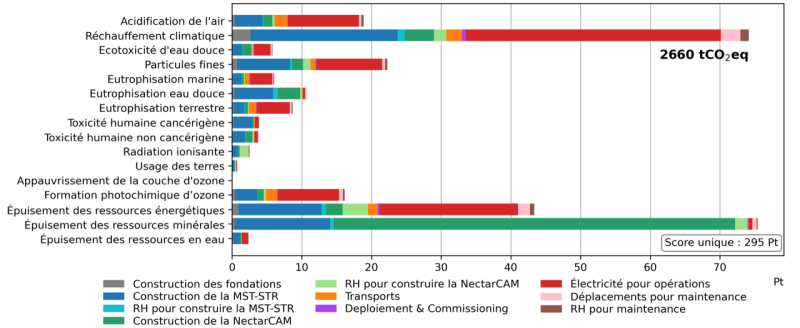How can we reduce the environmental impact of astronomical telescopes?
Telescopes, their construction and operation, have recently been identified as major sources of greenhouse gases emitted by astronomical research activities. Yet greenhouse gases are not the only pressure on the Earth’s climate: six of the nine planetary limits required for the Earth system to function properly are currently being exceeded due to human activities.
In order to define ways of reducing the environmental impact of astronomical observation methods, it is necessary to determine all these impacts. An interdisciplinary scientific team, bringing together researchers from CNRS Terre & Univers, CNRS Ingénierie and CNRS Nucléaire & Particules, has studied this issue for the first time through a life cycle analysis of a telescope soon to be installed on the island of La Palma, Spain.

The study shows that greenhouse gas emissions and the depletion of natural resources are the main environmental impacts of the telescope. The analysis suggests that the telescope will emit 2660 (+/- 274) tCO2eq over its lifecycle, of which 44% comes from its construction, 1% from its on-site installation, and 55% from its operation over 30 years.
These emissions could be reduced by 46% by powering the telescope with renewable energy, rather than the diesel generators currently installed on the island. Other ways of reducing environmental impact include reducing the number of electronic components used in the camera, using less energy-intensive processes to manufacture the telescope, and using recycled materials. The study also reveals the importance of considering environmental impacts right from the design phase of a telescope, and thus adding environmental budgets to the project specifications.
Laboratories involved
- CNRS Laboratories
- Institut de Recherche en Astrophysique et planétologie (IRAP – OMP) – Tutelles : CNRS / CNES / Université Toulouse III – Paul Sabatier
- Laboratoire de génie chimique (LGC) – Tutelles : CNRS / TOULOUSE INP / Université Toulouse III – Paul Sabatier
- Laboratoire Physique Nucléaire et Hautes Energies (LPNHE) – Tutelles : CNRS / Sorbonne Université
- Others
- INAF, Osservatorio Astronomico di Brera, Italie
- Deutsches Elektronen-Synchrotron DESY, Allemagne
Further Resources
- Scientific Publication : dos Santos Ilha, G., Boix, M., Knödlseder, J. et al. Assessment of the environmental impacts of the Cherenkov Telescope Array mid-sized telescope. Nat Astron (2024). https://doi.org/10.1038/s41550-024-02326-4
- CNRS Press Release : Comment réduire l’impact environnemental des télescopes astronomiques ?
IRAP Contact
- Jürgen Knödlseder, jknodlseder@irap.omp.eu






